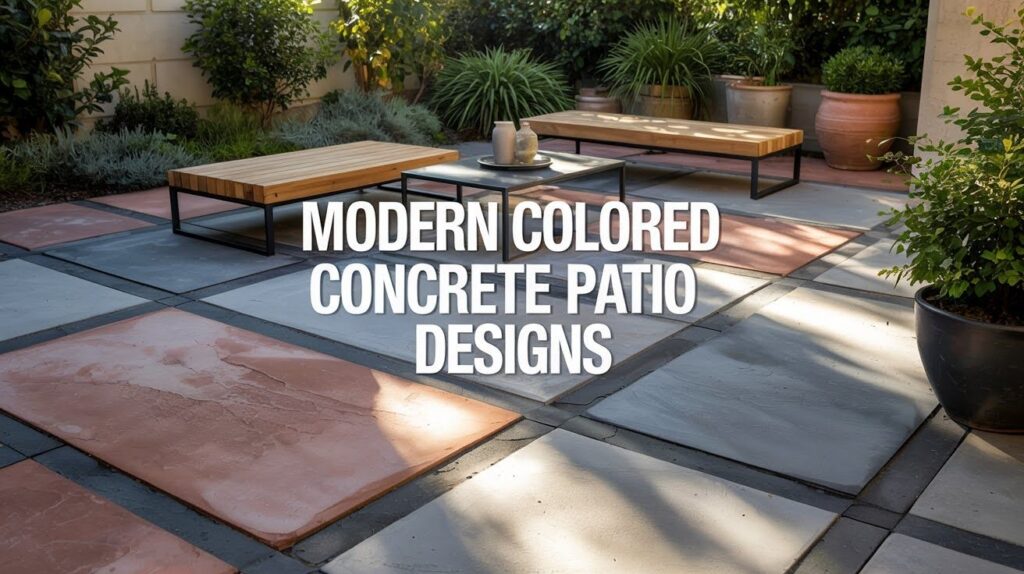Colored concrete patios are changing how we think about outdoor spaces. Gone are the days of plain gray slabs. Today’s homeowners want patios that match their style and complement their homes.
These surfaces offer incredible durability. They resist weather, stains, and heavy use better than many other materials.
The design options are virtually limitless. You can choose subtle earth tones or make a bold statement with bright colors. Texture options range from smooth finishes to rough, natural looks.
Many homeowners hesitate because they think concrete looks boring or industrial. That’s simply not true anymore. Modern coloring techniques create surfaces that rival expensive materials like natural stone or imported tile.
I’ll show you 15 inspiring designs that work with different home styles. From sleek modern spaces to cozy rustic retreats, there’s something here for everyone.
Sleek & Minimalist Designs
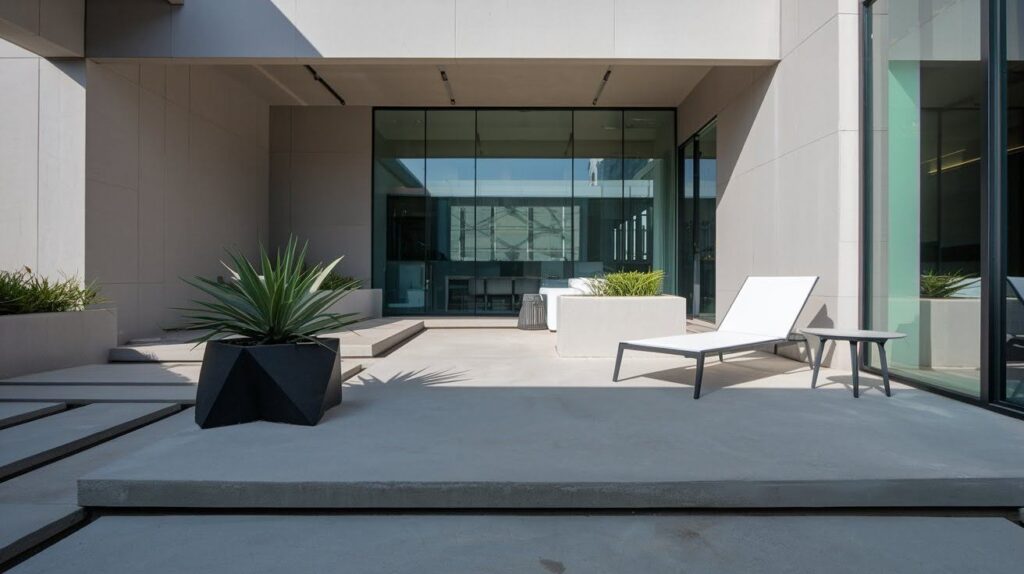
1. Cool Gray Finish with Clean Lines
Gray concrete patios create a sophisticated foundation for modern homes. This neutral color works with any furniture style.
The key is keeping lines sharp and surfaces smooth. Add geometric planters or linear seating to enhance the contemporary feel.
This design works especially well with white, black, or steel gray homes. It creates a seamless flow from indoor to outdoor spaces.
2. Charcoal-Tinted Concrete with Metal Accents
Dark charcoal concrete makes a dramatic statement. It’s perfect for urban homes with industrial vibes.
Pair this deep color with steel furniture and copper planters. The contrast creates visual interest without overwhelming the space.
This shade also hides dirt and stains better than lighter colors. That makes it practical for high-traffic areas.
3. Monochrome Patio with Matching Furniture
Create a unified look by matching your concrete color to your furniture. Choose a medium gray and add furniture in similar tones.
This approach makes small patios feel larger. It also creates a calm, relaxing atmosphere.
Add interest with different textures rather than colors. Think smooth concrete, woven cushions, and rough pottery.
Natural & Earthy Tones
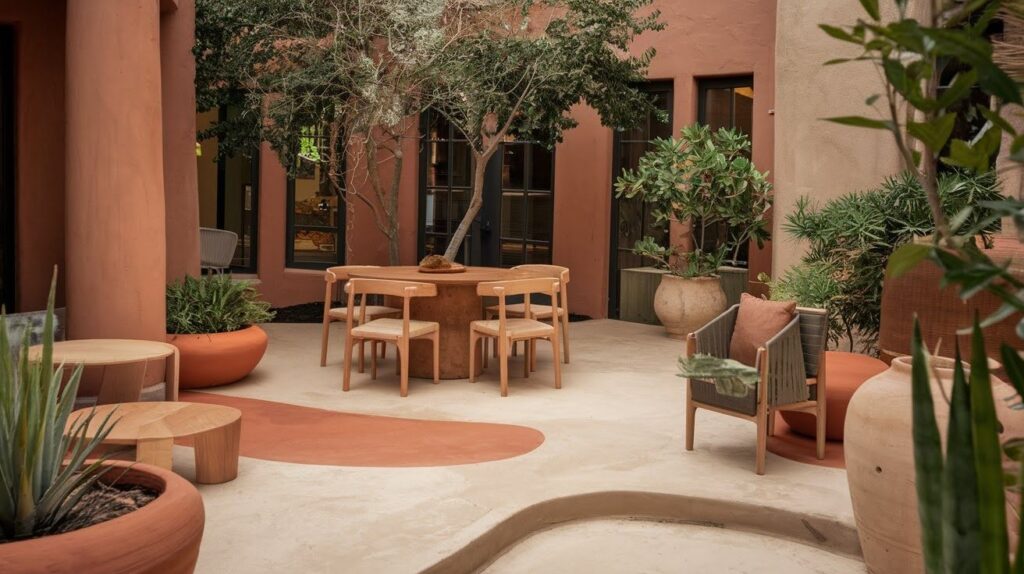
4. Warm Terracotta-Tinted Concrete
Terracotta brings warmth to any outdoor space. This reddish-brown color complements Spanish, Mediterranean, and Southwestern homes perfectly.
The earthy tone pairs beautifully with natural materials. Think wooden furniture, clay pots, and stone accents.
This color also works well in desert climates. It blends with the natural landscape while staying cool underfoot.
5. Sandstone Beige with Textured Finish
Beige concrete creates a warm, welcoming atmosphere. It mimics natural sandstone but costs much less.
Add texture to make it more interesting. Brushed or stamped finishes create depth and visual appeal.
This neutral shade works with almost any color scheme. It’s especially good for traditional or transitional home styles.
6. Olive or Moss Green Patios
Green concrete might sound unusual, but it creates magic in garden settings. Choose subtle olive or moss tones for best results.
This color blends beautifully with plants and grass. It makes your patio feel like a natural extension of your garden.
Green concrete works well in shaded areas too. It won’t show dirt as easily as lighter colors.
Bold & Vibrant Choices
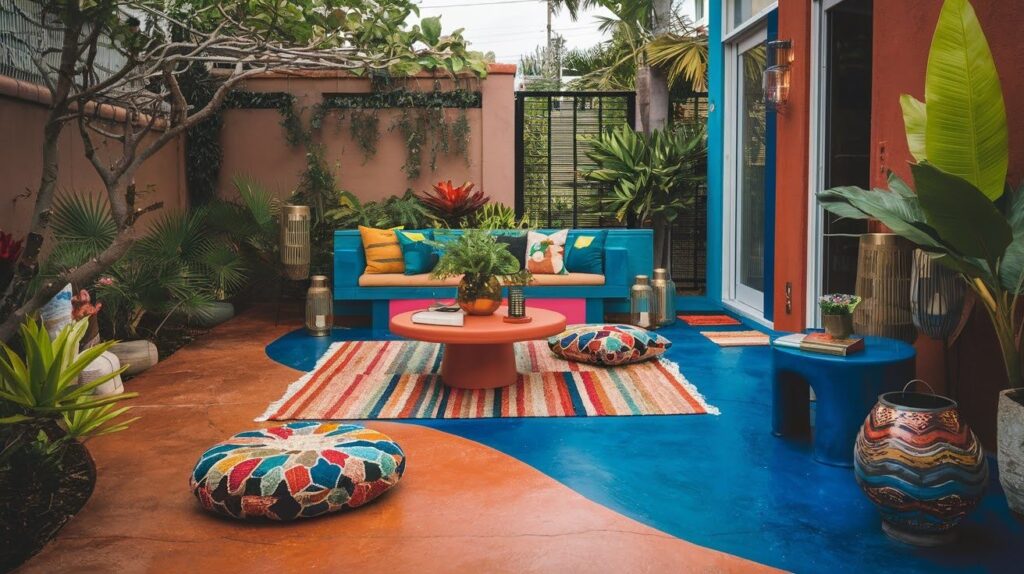
7. Rust Red Concrete Patio for a Southwest Vibe
Rust red concrete brings desert beauty to your backyard. This bold color works especially well in Southwestern and ranch-style homes.
The warm tone complements clay pots, cacti, and desert plants. It also looks great with natural wood furniture.
This color stays relatively cool in hot climates. The earthy tone doesn’t reflect harsh sunlight like lighter colors do.
8. Cobalt Blue Accented Concrete
Blue concrete creates a unique focal point around pools or water features. Choose deeper blues rather than bright ones for better results.
This color works well as an accent rather than covering the entire patio. Use it for borders or specific zones.
Pair blue concrete with white or cream furniture. The contrast creates a fresh, coastal feel.
9. Sunset Orange Patio for Tropical Feel
Orange concrete brings energy to outdoor spaces. This warm color works well in tropical or Mediterranean settings.
Choose muted orange tones rather than bright ones. Terra cotta orange or burnt orange create better long-term appeal.
This color pairs well with green plants and brown furniture. It creates a warm, inviting atmosphere for entertaining.
Mixed Finish & Custom Effects
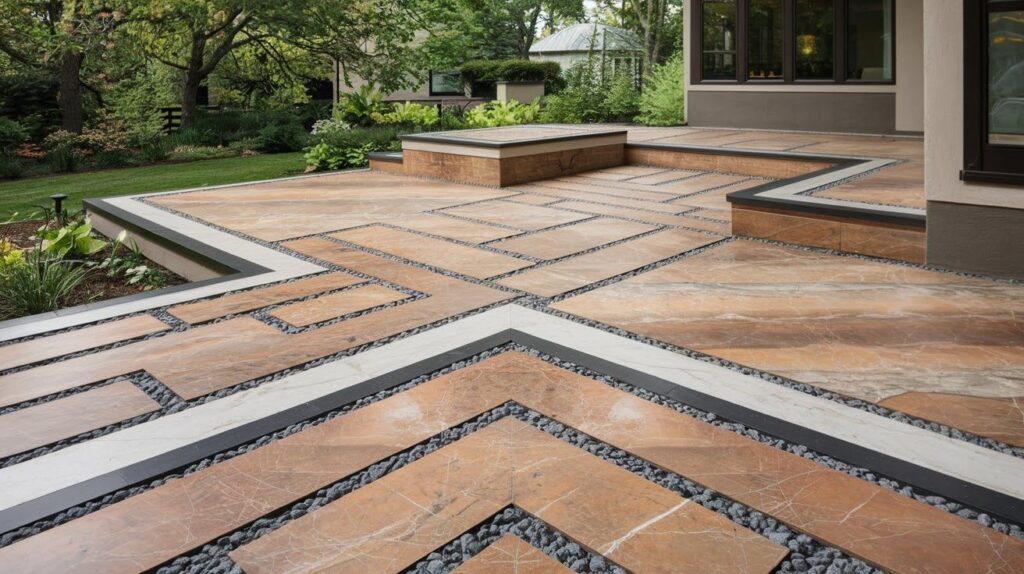
10. Two-Tone Designs with Contrasting Borders
Combine two colors to create visual zones in large patios. Use a neutral base color with a darker border.
This technique helps define seating areas, dining spaces, or walkways. It adds structure without requiring walls or barriers.
Popular combinations include gray with charcoal borders or beige with rust red accents.
11. Colored Concrete with Exposed Aggregate
Exposed aggregate adds texture and visual interest to colored concrete. Small stones show through the surface creating a speckled effect.
This technique works especially well with earth tones. The natural stones complement the concrete color.
The textured surface also provides better traction when wet. That makes it safer around pools or in rainy climates.
12. Marbled or Stained Effects
Create the look of natural stone with marbled concrete effects. Multiple colors blend together for a sophisticated appearance.
This technique works well with neutral colors. Blend beiges, grays, and browns for a natural stone look.
The varied colors help hide dirt and wear patterns. Your patio will look newer longer.
Stamped & Patterned Patios
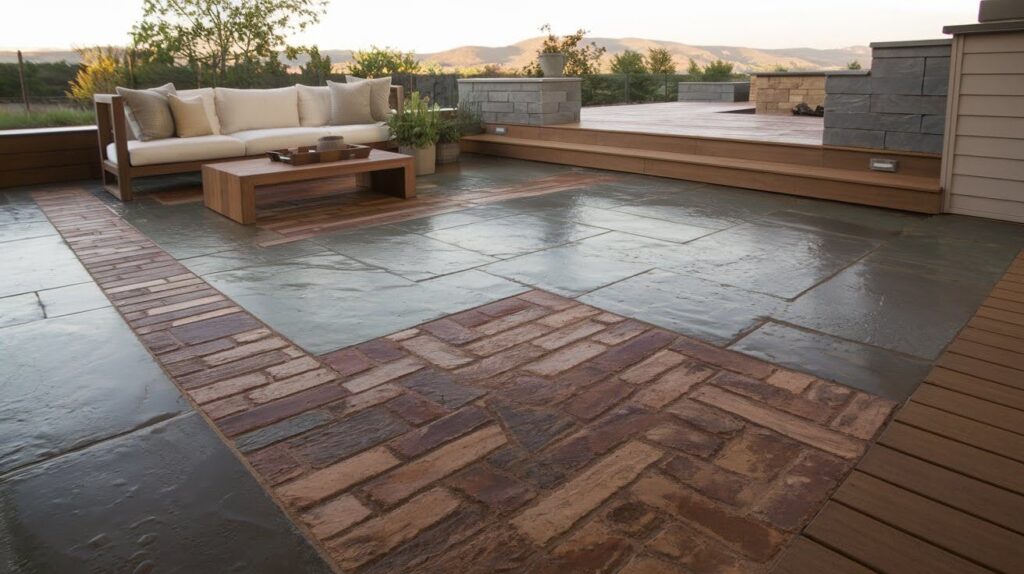
13. Wood-Look Stamped Colored Concrete
Get the beauty of hardwood with concrete’s durability. Stamped patterns create realistic wood grain textures.
Choose brown or gray-brown colors for the most realistic effect. The stamping process adds depth and shadow lines.
This option costs less than real wood and requires much less maintenance. It won’t rot, warp, or need regular staining.
14. Brick-Pattern Stamps in Deep Red or Brown
Traditional brick patterns never go out of style. Stamped concrete can mimic this classic look at a lower cost.
Choose deep red or brown colors for authentic brick appearance. The stamping process creates mortar lines and texture.
This design works well with colonial, traditional, or cottage-style homes. It creates a timeless, classic feel.
15. Slate-Look Concrete with Color Variations
Slate patterns create an upscale appearance for a fraction of natural stone costs. The irregular shapes look completely natural.
Use gray or blue-gray colors for the most realistic slate effect. Add color variations to mimic natural stone patterns.
This sophisticated look works well with modern and traditional homes alike. It provides a premium appearance without premium costs.
How to Maintain Your Colored Concrete Patio
Regular Cleaning
- Sweep debris weekly to prevent staining
- Wash with mild detergent monthly
- Rinse thoroughly after cleaning
Sealing Protection
- Apply sealer every 2-3 years
- Choose UV-resistant products for colored concrete
- Clean surface before applying new sealer
Stain Prevention
- Clean spills immediately
- Use furniture pads to prevent scratches
- Avoid harsh chemicals or deicing salts
Seasonal Care
- Remove leaves and organic matter promptly
- Check for cracks after freeze-thaw cycles
- Repair small cracks before they spread
Conclusion
Colored concrete patios offer incredible design flexibility for every home style. From subtle grays to bold terracotta, there’s a color that fits your vision and budget.
The key is choosing colors that complement your home and landscape. Consider your climate, maintenance preferences, and long-term appeal when making decisions.
These 15 designs show just how versatile colored concrete can be. You can create anything from sleek modern spaces to warm, rustic retreats.
Start by determining your style preferences and practical needs. Then work with a qualified contractor to bring your vision to life. Your new patio will provide years of outdoor enjoyment.
Frequently Asked Questions
How long does colored concrete patio last?
Properly installed colored concrete patios can last 20-30 years or more. Regular maintenance like sealing every 2-3 years helps preserve both color and durability. The concrete itself is extremely durable, while the color may fade slightly over time without proper care.
Is colored concrete more expensive than regular concrete?
Colored concrete typically costs 10-15% more than plain concrete. The color additives and specialized techniques add to material and labor costs. However, it’s still much less expensive than natural stone or premium pavers while offering similar visual appeal.
Can I change the color of existing concrete patio?
Yes, you can change existing concrete color through staining, painting, or overlay systems. Acid stains create permanent color changes, while concrete paints offer more color options but may require more maintenance. Overlays allow complete design changes but cost more.
Will colored concrete fade in sunlight?
High-quality colored concrete resists fading well, but some color change is normal over time. UV-resistant sealers help protect the color significantly. Earth tones like browns and grays fade less noticeably than bright colors. Regular sealing maintains color vibrancy longer.
How do I choose the right color for my home?
Consider your home’s exterior colors, landscaping, and personal style preferences. Neutral colors offer more flexibility and timeless appeal. Test small samples in different lighting conditions before committing. Consider how the color will look with your outdoor furniture and plants.

